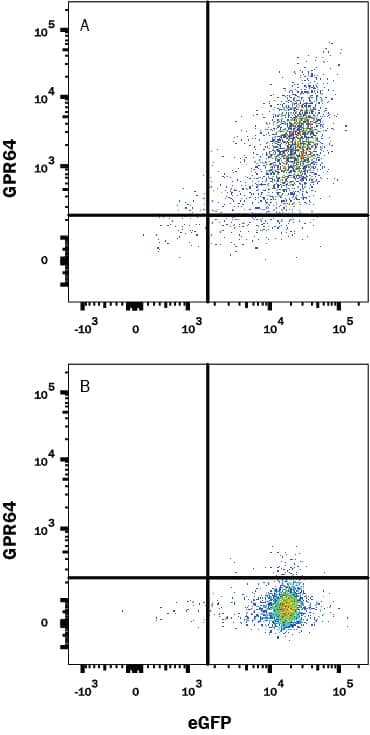Human GPR64 Antibody
R&D Systems, part of Bio-Techne | Catalog # MAB79771


Key Product Details
Species Reactivity
Applications
Label
Antibody Source
Product Specifications
Immunogen
Leu38-Asn64, Glu68-Thr553
Accession # NP_001073328
Specificity
Clonality
Host
Isotype
Scientific Data Images for Human GPR64 Antibody
Detection of GPR64 in HEK293 Human Cell Line Transfected with Human GPR64 and eGFP by Flow Cytometry.
HEK293 human embryonic kidney cell line transfected with (A) human GPR64 or (B) irrelevant transfectants and eGFP was stained with Mouse Anti-Human GPR64 Monoclonal Antibody (Catalog # MAB79771) followed by APC-conjugated Anti-Mouse IgG Secondary Antibody (Catalog # F0101B). Quadrant markers were set based on control antibody staining (Catalog # MAB002). View our protocol for Staining Membrane-associated Proteins.GPR64 in Human Epididymis.
GPR64 was detected in immersion fixed paraffin-embedded sections of human epididymis using Mouse Anti-Human GPR64 Monoclonal Antibody (Catalog # MAB79771) at 5 µg/mL for 1 hour at room temperature followed by incubation with the Anti-Mouse IgG VisUCyte™ HRP Polymer Antibody (Catalog # VC001). Before incubation with the primary antibody, tissue was subjected to heat-induced epitope retrieval using Antigen Retrieval Reagent-Basic (Catalog # CTS013). Tissue was stained using DAB (brown) and counterstained with hematoxylin (blue). Specific staining was localized to cell surface in principal cells. View our protocol for IHC Staining with VisUCyte HRP Polymer Detection Reagents.Applications for Human GPR64 Antibody
CyTOF-ready
Flow Cytometry
Sample: HEK293 Human Cell Line Transfected with Human GPR64 and eGFP
Immunohistochemistry
Sample: Immersion fixed paraffin-embedded sections of human epididymis
Formulation, Preparation, and Storage
Purification
Reconstitution
Formulation
Shipping
Stability & Storage
- 12 months from date of receipt, -20 to -70 °C as supplied.
- 1 month, 2 to 8 °C under sterile conditions after reconstitution.
- 6 months, -20 to -70 °C under sterile conditions after reconstitution.
Background: GPR64
GPR64 (G-Protein coupled Receptor 64; also HE6) is a 110 kDa (predicted) member of the B class of GCPRs. Within this class GPR64 belongs to a Large N-termini family-B 7-transmembrane (LNB-7TM) subclass of receptors (also known as adhesion-GCPRs). GPR64 has restricted expression, being found in stereocilia cell membranes of epididymal caput epithelial cells and, to a limited extent, on osteoblasts. The function of GPR64 is somewhat unclear, but in the epididymis, it may be involved in fluid transport. Mature human GPR64 is a 980 amino acid (aa) 7-TM glycoprotein (SwissProt Q8IZP9). It contains an extended extracellular N-teminus (aa 38-627), seven consecutive TM segments (aa 628-878) and a C-terminal cytoplasmic tail (aa 879-1010). The extended extracellular region possesses a juxtamembrane GPS domain (aa 567-618) that serves as a proteolytic cleavage site. Enzymatic activity here generates a 180 kDa soluble form that stays associated with a 40 kDa membrane-embedded fragment. Notably, isolation of the membrane fragment gives rise to oligomers that run at > 250 kDa in SDS-PAGE. There are multiple splice variants. The one used for immunization to generate this antibody contains a deletion of aa 88-101 (RefSeq NP_001073328). Four other splice forms show single block deletions of aa 65-67, 51-66, 52-75, and 906-956, respectively. Three others possesses aa substitutions; a 20 aa block for aa 52-101, and a common 12 aa block that can substitute for either aa 68-101 or aa 52-101. Over aa 38-64 and 68-553 of RefSeq NP_001073328, human and mouse GPR64 share 69% aa sequence identity.
Long Name
Alternate Names
Gene Symbol
UniProt
Additional GPR64 Products
Product Documents for Human GPR64 Antibody
Product Specific Notices for Human GPR64 Antibody
For research use only
